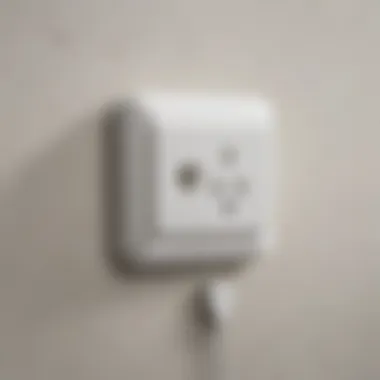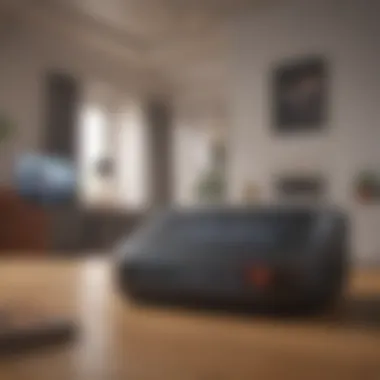Kasa Devices and Apple HomeKit: A Compatibility Guide


Intro
In today’s fast-paced world, where technology becomes more intertwined with our daily lives, smart home devices have emerged as essential elements of modern living. Many consumers are attracted to Kasa smart home devices, known for their affordability and functionality. However, the question remains: how well do these devices integrate with Apple's HomeKit framework? This guide will unravel the layers of compatibility between Kasa products and the Apple ecosystem, providing insights into user experiences, practical usage, and future possibilities for such integrations.
Kasa offers a variety of smart devices, including smart plugs, light bulbs, and cameras, each boasting distinctive features. On the other hand, Apple’s HomeKit stands as a beacon within the smart home industry, promoting an integrated and user-friendly experience for iOS users. Thus, an exploration of how these two diligent forces meet can reveal important insights for consumers who lean towards building a smart home tailored to their needs.
The focus of this article will be twofold: first, to examine the technical compatibility and features that Kasa devices bring to the HomeKit landscape, and second, to evaluate the overall user experience to better understand if these devices can fully satiate the demand of Apple enthusiasts alongside their robust security standards.
Prolusion to Kasa and HomeKit
Smart home technology has fundamentally transformed how we interact with our living spaces. In this dynamic environment, Kasa represents a key player in the realm of smart devices, while Apple HomeKit emerges as a prominent framework for connectivity and control. Understanding how these two can work together presents an exciting opportunity for tech enthusiasts, and it’s a subject well worth exploring.
The integration of Kasa devices with Apple HomeKit holds significance for a variety of reasons. For starters, Kasa’s array of smart devices—from plugs and cameras to smart bulbs—offers a broad spectrum of functionalities that can be effectively harnessed through HomeKit's intuitive interface. This combination enhances the user's experience, enabling effortless management of gadgets from a single platform. Users can enjoy features like remote access, automation, and voice control, all neatly bundled within Apple’s ecosystem.
However, this compatibility doesn't come without its challenges. Factors like connectivity issues, device limitations, and the initial setup can present roadblocks along the way. Nonetheless, the possibilities for creating a seamless smart home experience make these hurdles worth overcominbg. By delving deeper into the insights surrounding Kasa and HomeKit, we uncover not only the current capabilities and limitations but also future trends in smart home interoperability that will shape consumers' experiences in the coming years.
In the context of Kasa's offerings, it's crucial to identify specific components that integrate smoothly with HomeKit compared to others that may not. This kind of awareness helps potential users make informed decisions and maximize their investments in smart home technology.
The prospect of merging Kasa’s innovative solutions with Apple’s HomeKit speaks to the heart of a smarter, more interconnected living environment.
Consequently, before diving into the technicalities, it's essential to establish a solid foundation about each entity—specifically, what Kasa devices are all about and what Apple HomeKit entails.
The Importance of Smart Home Integration
In the ever-evolving world of technology, smart home integration stands as both a beacon of possibility and a multilayered puzzle. As we witness a rapid shift towards automation in our households, understanding the significance of seamless connections between devices has never been more crucial. It's easy to become enamored with the luster of shiny new gadgets, but their true value blossoms only when they work in harmony, creating a coherent ecosystem that simplifies our lives.
Smart home integration isn't simply about connecting various devices; it is fundamentally about enhancing convenience, security, and energy efficiency. Imagine controlling the lighting, security cameras, and appliances in your home with a single touch or voice command. This is the promise of a unified smart home system, which bridges the gap between disparate brands like Kasa and platforms like Apple HomeKit.
"A smart home isn’t just a collection of gadgets; it’s a smart lifestyle."
Benefits of a Unified Smart Home System
Having a unified smart home system offers several compelling advantages:
- Enhanced Convenience: One app or interface to control everything saves time and frustration. You don’t need to juggle multiple apps for different devices; instead, you get one streamlined solution.
- Improved Security: Coordinated devices can communicate with one another, which enhances security. For instance, if a motion sensor detects movement, it could prompt your smart cameras to record automatically.
- Energy Efficiency: Smart lights and plugs can be programmed to operate only when needed. This level of control can lead to significant energy savings.
- Increased Functionality: Integration allows for more complex automation routines, turning your home into a responsive environment.
- Future-Proofing: As technology continues to advance, investing in compatible devices today ensures that your smart home ecosystem can adapt and grow.
These elements coalesce into a systematic advantage that enhances daily living. The idea of interconnectivity resonates especially with tech-oriented users looking to maximize their smart homes' capabilities.
Challenges of Compatibility
However, while the benefits of a unified smart home experience are clear, the road isn’t always smooth. There are notable challenges that arise from the integration of devices from different manufacturers, such as:
- Limited Compatibility: Not all devices can seamlessly communicate due to differing protocols and standards, which can lead to a frustrating user experience.
- Installation Complexities: Getting different devices to work together may require additional setup steps, sometimes involving intermediary solutions like Homebridge, which can become cumbersome.
- Updating Devices: Maintaining compatibility as firmware or software updates are released can pose a challenge; a device that once worked perfectly might end up being left behind.
- Vendor Lock-in: Some users find themselves tied to one brand or ecosystem, restricting their options when searching for new devices.


As a result, potential new adopters must weigh these compatibility hurdles against the rewards of an integrated smart home. For Kasa users looking to cozy up to Apple HomeKit, comprehending these challenges serves as a stepping stone to effective implementation and satisfaction.
Kasa Device Features
In the realm of smart home technology, the features offered by Kasa devices play a pivotal role in how seamlessly they can integrate with Apple HomeKit. Kasa's smart home devices, which include plugs, cameras, and lighting solutions, cater to a diverse range of needs, making them an attractive option for those looking to enhance their home with innovative technology. The selection and variety of features available not only enhance user convenience but also address critical concerns such as energy management and security.
One of the appealing aspects of Kasa devices is their versatility. They typically operate through the Kasa app, enabling users to manage their smart gadgets effortlessly. Furthermore, the compatibility of Kasa devices with Apple HomeKit opens up a whole new world of possibilities for users entrenched in the Apple ecosystem. This relationship enhances the functionality of both platforms, making it a topic worth exploring in depth.
Smart Plugs and Their Capabilities
Smart plugs are often seen as the gateway to home automation. They allow users to convert traditional appliances into smart devices by enabling remote control through mobile applications. Kasa smart plugs stand out due to their reliable performance and ease of use.
- Energy Monitoring: One feature that many users appreciate is the built-in energy monitoring functionality. This offers insights into how much power connected appliances consume, empowering users to manage their electricity usage more effectively.
- Scheduling Options: Users can set schedules to turn devices on or off at specific times. This is particularly useful for managing lamps or coffee makers, ensuring convenience without any hassle.
- Voice Control: When paired with Apple HomeKit, these plugs become voice-controlled, allowing for a hands-free experience.
The combination of these features makes Kasa smart plugs an integral part of any smart home setup, boosting both practicality and efficiency.
Kasa Cameras: Security Meets Convenience
With security being a primary concern for many homeowners, Kasa's range of cameras provides essential features designed with user safety in mind. These cameras combine high-resolution video with excellent user experience.
- Motion Detection and Alerts: Kasa cameras utilize advanced motion detection technology. Users receive notifications via the Kasa app whenever movement is detected, allowing them to respond swiftly to any unusual activity.
- Cloud Storage Options: The availability of cloud storage enhances the convenience further, as users can access recorded footage remotely, ensuring they never miss an important moment.
- HomeKit Integration: Users can easily manage camera feeds through Apple HomeKit, integrating with other devices to create a comprehensive home security system.
This blend of features not only ensures safety but also provides peace of mind, making Kasa cameras a vital component for those concerned about security at home.
Smart Bulbs and Lighting Solutions
Lighting is an often overlooked aspect of home automation, yet it can significantly impact the atmosphere of a living space. Kasa's smart bulbs offer flexibility and control over lighting that traditional bulbs simply cannot match.
- Customizable Colors and Brightness: With hundreds of color combinations and dimming options, you can create the perfect ambiance for any occasion. Whether it's a bright light for work or warm tones for relaxation, Kasa smart bulbs offer it all.
- Automation Features: Users can schedule lights to turn on or off at specific times, ensuring that your home is always welcoming, or set up scenes for special moments.
- HomeKit Compatibility: Integrating with Apple HomeKit allows for enhanced interactivity with other smart devices, providing a higher level of control and customization.
This level of adaptability in Kasa smart bulbs contributes to developing a truly smart living environment, improving both functionality and aesthetic appeal.
In essence, Kasa's device features exemplify the future of smart home technology, where convenience, efficiency, and security are harmoniously intertwined.
Connecting Kasa Devices to HomeKit
Kasa smart home devices make life easier, offering better control over your home’s environment. Connecting these devices to Apple’s HomeKit enhances their functionality, enabling users to access greater levels of integration and control. With HomeKit, Apple brings a structured approach to managing smart devices, allowing users to create automated routines and control devices via Siri. But why is this connectivity significant?
When Kasa devices interact seamlessly with HomeKit, it opens a treasure trove of benefits. Users can monitor and control devices from a single app, which significantly simplifies the smart home experience. Also, it allows for custom scenes and automations. For instance, you could set the mood for movie night by dimming Kasa smart bulbs while also turning on a Kasa smart plug to power your popcorn maker. This kind of integration is what modern smart homes are all about.
However, connecting Kasa devices to HomeKit isn't without its moments of frustration. There are subtleties in the setup process that can trip up even seasoned tech enthusiasts. Let’s dive into how to get started with the initial setup and what requirements you need to keep an eye on.
Initial Setup and Requirements


To begin your journey of connecting Kasa devices with HomeKit, it’s essential to set the stage properly. First and foremost, check that your Kasa device is compatible with Apple’s HomeKit. Not all Kasa products offer this feature, so visiting the official TP-Link Kasa website is a good first move to cross-check compatibility.
Following compatibility verification, ensure you have the necessary hardware at hand:
- A Kasa device setup and powered on: This could be a smart plug, bulb, or any other Kasa smart appliance.
- An iOS device: Either an iPhone, iPad, or iPod Touch running iOS 10 or later.
- The Kasa Smart app: Download this from the App Store, as you'll need it to connect your device to Wi-Fi initially.
- HomeKit setup: You'll need to have the Home app installed and set up on your iOS device.
Once you’ve gathered all these items, you’re ready to follow the steps to connect your Kasa devices. Most setups involve these straightforward steps:
- Open the Kasa app and log in to your account.
- Add your Kasa device and follow the instructions for connecting it to your Wi-Fi network.
- Open the Home app, and tap on the icon to add an accessory.
- Scan the HomeKit QR code available in the Kasa app.
"Smart homes should feel smart, not complicated."
This initial setup phase can be deceptively simple, but challenges can crop up, which leads us to alternative methods of integration.
Using Homebridge for Integration
Not all Kasa devices can be connected directly to HomeKit, which can leave some users feeling left out in the cold. But don’t fret – the community has found a workaround through a platform called Homebridge. It acts like a middle-man, making it possible to connect devices that lack native HomeKit support.
Homebridge is a lightweight Node.js server that replicates the HomeKit API and allows you to integrate various smart home devices that do not support HomeKit out of the box. If you're the hands-on type or willing to undertake a bit of tech heavy lifting, here’s how to get your Kasa devices working through Homebridge:
- Install Node.js and npm on your computer or a Raspberry Pi.
- Use the terminal to install Homebridge:
- Install the Kasa plugin for Homebridge by running:
- Configure the Homebridge config.json file, inputting your Kasa device data within the Homebridge framework.
- Restart Homebridge and add it to your Home app.
By following these steps, your Kasa device can join the ranks of HomeKit environments, thanks to Homebridge. Remember to regularly check for plugin updates and ensure everything is running smoothly.
Ultimately, connecting Kasa devices to HomeKit not only amplifies their potential but also solidifies your smart home’s backbone, making way for clever automation opportunities.
User Experience and Feedback
Understanding user experience and feedback is crucial when evaluating the compatibility of Kasa smart devices with Apple’s HomeKit. The way consumers interact with technology greatly influences their satisfaction and overall perception of a product. In the realm of smart homes, where devices are interconnected, the user experience can either enable seamless functionality or lead to frustration.
When users talk about experience, they're often referencing how intuitive the setup process is, the reliability of connections, and the efficacy of device interactions. A smooth setup allows users—be they tech novices or more experienced individuals—to feel empowered. They should be able to integrate Kasa devices without needing a degree in electrical engineering. Moreover, if users find that the devices respond to commands promptly and seamlessly interact with HomeKit, this enhances their overall appreciation for the Kasa ecosystem.
Benefits of prioritizing user experience include improved customer loyalty. Satisfied users are more likely to recommend Kasa products to friends and family, which can lead to organic growth in their customer base. Companies that pay close attention to user feedback can also fine-tune their products—be it through updates, added features, or improved compatibility, setting the stage for greater overall satisfaction.
Case Studies of Kasa and HomeKit Users
Exploring real-life examples can provide valuable insights into how users navigate their experience with Kasa and HomeKit. For instance, let’s talk about Jen, a mom of three who integrated Kasa smart plugs into her home. With the combination of her iPhone and HomeKit, she set schedules for her kids' bedtime lamps. Jen found that once everything was set up, her children actually adhered to their routines better, thanks to the predictable patterns that the smart devices provided.
Conversely, we have Mark, a tech aficionado who has highly customized his smart home with various Kasa devices. His story highlights the need for flexibility and options within the integration. Mark appreciated the seamless voice control via Siri, yet he ran into issues when attempting to control multiple devices at once. Despite these hiccups, he admired the continuous updates from Kasa, which demonstrated the brand’s commitment to improving functionality.


These examples illustrate the diverse ways users benefit from Kasa’s compatibility with HomeKit while underscoring common challenges.
Common Issues Encountered
While the potential for a cohesive smart home experience is enticing, it’s essential to acknowledge the stumbling blocks that users have faced. One common issue reported by Kasa users integrating with HomeKit is unpredictability in device responsiveness. Imagine turning on a light, only to be met with a five-second delay. Such setbacks can be frustrating, especially when users rely on instant control for daily tasks.
Another notable challenge is the setup process itself. Some users have found navigating through the Homebridge installation particularly daunting. If bridging devices require a bit of finesse in understanding IP configurations, it can deter less tech-savvy customers. This gap hinders widespread enthusiasm for merging Kasa with HomeKit.
Inconsistent performance or connectivity issues can also arise depending on the home’s Wi-Fi setup and network strength. Not all homes are equipped with top-of-the-line routers, and some users have noted that their devices occasionally drop off the network or fail to respond due to weak signals.
"User experience centers on reliability and control—anything less can tarnish the adoption of smart technologies."
Future of Smart Home Interoperability
The future of smart home interoperability certainly stands as a pivotal element in the ongoing evolution of smart technology. As more consumers embrace smart devices, the demand for compatibility among various systems has surged. This drive toward unity is not merely a trend, but a necessity for a seamless user experience. By connecting different devices from various manufacturers, users gain the flexibility and convenience they seek.
Trends in Smart Home Technology
Looking at the horizon of smart home technology, a few noticeable trends take center stage. One major trend is the integration of artificial intelligence in home automation systems. This advancement is akin to having a personal assistant who adapts to your preferences over time. The more these systems learn, the smarter they become, increasing efficiency and usability.
Another emerging trend is the increasing popularity of voice-activated controls. With the likes of Amazon Alexa and Google Assistant leading the charge, consumers are now looking for devices that can work with multiple voice assistants. This demand puts pressure on manufacturers to develop products that not only function well on one platform but also across several, ensuring maximum compatibility.
Additionally, more consumers are becoming environmentally conscious, leading to a surge in energy-efficient devices. These products are often designed to operate in a fully integrated smart home environment, where data from devices can inform usage patterns and promote greener living.
The Role of Standards and Protocols
Standards and protocols play a crucial role in making smart homes truly interoperable. They serve as the bridge connecting disparate technologies. For instance, the introduction of Matter, a connectivity standard supported by major players, aims to simplify communication between devices. By adhering to uniform standards, manufacturers can create products that communicate more effectively, ultimately benefiting the consumer.
Consider the analogy of a universal remote control. It combines multiple functions into one tool, reducing the clutter of remotes while enhancing convenience. Similarly, industry standards look to eliminate the fragmentation that often plagues the smart home ecosystem.
Moreover, robust security protocols are vital to safeguard user data, especially as smart homes collect extensive information about habits and preferences. For example, manufacturers incorporating these standards can protect users from potential breaches while ensuring a smooth user experience.
Ending
In the realm of smart home devices, the connection between Kasa and Apple HomeKit stands as a testament to the increasing versatility and usability of technology in everyday life. As we’ve explored throughout this piece, Kasa’s rich selection of smart devices aligns remarkably well with the ecosystem offered by HomeKit, providing a seamless interface for users looking to elevate their smart home experience.
Summary of Key Points
- Kasa Devices Compatibility: Kasa smart devices, ranging from plugs to cameras and bulbs, can be integrated into HomeKit, enhancing user control and coordination.
- Homebridge Integration: While direct compatibility might not exist for all Kasa devices, the use of Homebridge remains a practical solution, allowing for enhanced customization and increased device accessibility.
- User Experiences: Case studies indicate that users enjoy a unified control system for their smart devices, but some experience challenges, such as setup complexities and connectivity issues.
- Future Interoperability: The trend towards interoperability and standardized protocols in smart home technology suggests a more cohesive environment in the future, making integration smoother and simpler for all users.
Final Thoughts on Integration
Integrating Kasa devices with Apple HomeKit offers significant benefits for tech-savvy consumers looking to simplify their living environments. This integration not only enhances functionality but also promotes an atmosphere of comfort and convenience.
However, it is crucial to consider specific device limitations and the dependencies implied by Homebridge usage. As standards in smart home technology evolve, users can expect improvements in compatibility which could further reduce friction in device integration.
Overall, the journey of blending Kasa devices with HomeKit is filled with potential. As both platforms grow, so too will the opportunities for users to tailor their smart homes to their specific needs and preferences, paving the way for a more integrated and intuitive future in smart living.
"The connection between devices is where the real magic happens in the smart home experience."
By considering these factors and remaining informed about new developments, users can make educated decisions that will not only streamline their smart home interactions now, but also prepare them for advancements on the horizon.















